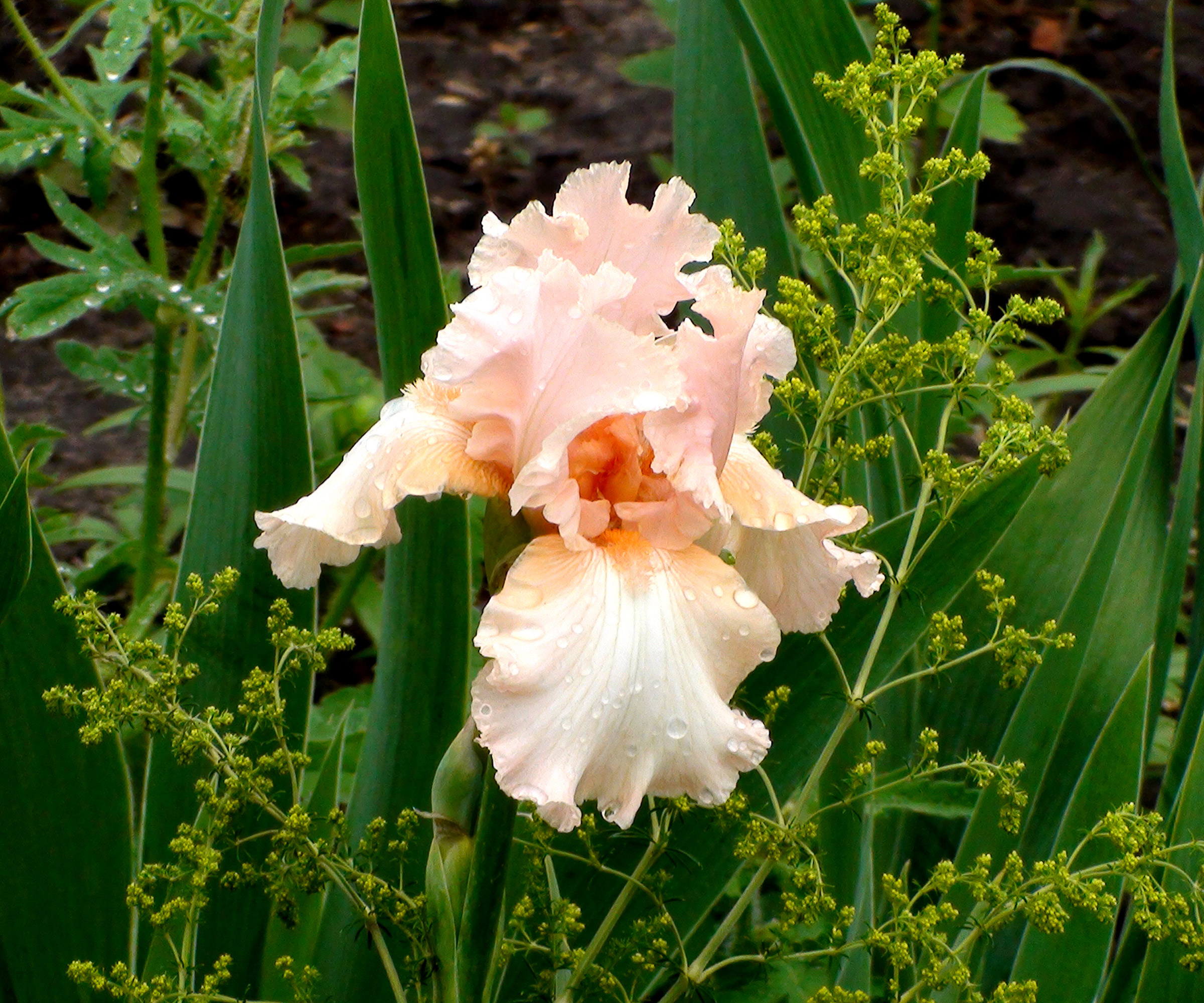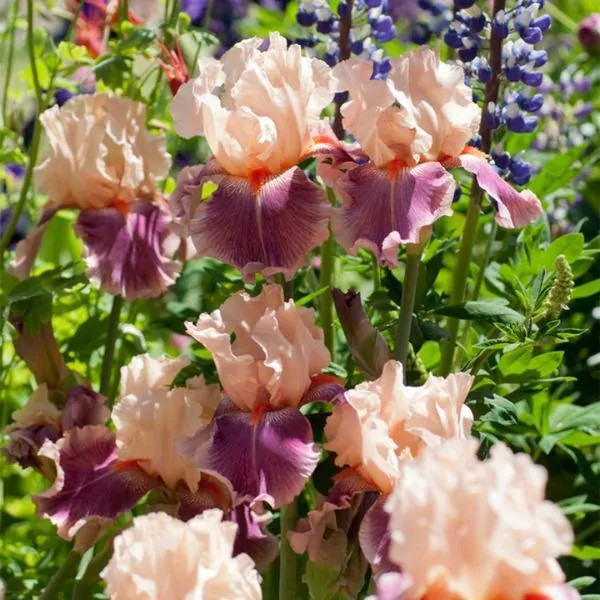How to grow bearded irises – for elegant, artistic and colorful blooms
Bearded irises are an English cottage garden favorite that require plenty of sunshine to thrive


Celebrated for their brilliant blooms, bearded irises are popular cottage garden favorites. With beautiful colors and markings, there are many different varieties of bearded irises, from golden yellow to maroon red, rusty copper to deep purple.
Bearded irises, Iris germanica, are so named for their distinctive beard found on the lower petals. When considering how to grow irises, this bearded form generally flowers from mid to late spring, with a short blooming period that usually lasts only 1 to 2 weeks. While the flowering time may be short, the artistry of these blooms makes them worth growing.
So, if you are seeking backyard ideas or looking for a spectacular yet intricate flower, bearded irises will impress in your backyard. Here, we share professional advice on how to grow bearded irises, to guarantee a profusion of flower spikes this year.

Bearded irises come in a range of colors. 'Benton Susan' seen here has copper-bronze tones
How to grow bearded irises
With many vibrant bearded iris varieties, there is surely one to suit any taste. The blooming of Iris Germanica is a spectacular floral show that will provide interest year after year in the garden borders. By following a few simple rules, you can ensure that this perennial not only returns but grows bigger and better each year.
Things to know about bearded irises

‘Beverly Sills’ blooms in an apricot-peach color
'Bearded Irises are considered perennials in US hardiness zone 3 to US hardiness zone 8,' says iris expert Katie Sunderlage. 'While some varieties can grow in US hardiness zone 9, most will struggle with such heat.'
They 'need to be planted in a full-sun location where they can receive at least 6 to 8 hours of full sun each day,' Katie adds. As is the case with flowering shrubs for full sun, 'remember that blooming is determined by sunlight. The more sunshine, the more flowers.'
In addition, these plants require 'well-draining soil,' Katie says. 'Bearded iris rhizomes are susceptible to root rot if the soil is waterlogged.' Irises typically grow in warm, dry regions in the Mediterranean and the Middle East, so providing your plant with good drainage is crucial.
Design expertise in your inbox – from inspiring decorating ideas and beautiful celebrity homes to practical gardening advice and shopping round-ups.
When selecting a bearded iris variety for your yard, be sure to pick one not only based on your color preferences but also on the size. Several bearded irises can reach 30 inches in height, but there are also some dwarf or miniature varieties. Taller irises make for an ideal plant for the middle or back of the border, while shorter varieties can be grown along pathways or in containers.

Operations Manager at Holland Group, managing the customer service department and purchasing. Katie has been in the green industry since 2005 in the Greater Milwaukee area, earning her degree in Horticulture in 2008. She has been able to share her love for plants working in multiple garden centers, in sales positions and most recently in an online retail platform at Holland Group.
How to plant bearded irises

'Ghost Train' in bloom with deep purple, almost black flowers
'Bearded irises should be planted in early fall,' Katie says. 'Generally, late August or September is the best time to plant them, as this gives plenty of time for the plant to establish before the cold, chilly winter months.'
'As with most perennials that can be planted in the fall, giving them as much time as possible in the ground before it freezes is a good idea,' Katie adds. 'Planting earlier, in late August or early September, will also increase the chances of them blooming the following season.'
'It is also important to make sure that the depth of the rhizome is correct. Bearded iris rhizomes need to be planted 1 to 2 inches below the soil surface, but the crown of the rhizome should sit just above the soil,' Katie adds. 'Planting too deep will likely cause the iris not to bloom or grow.'
It is a good idea to consider the position and route of the sun when planting, as rhizomes should enjoy the maximum amount of sunshine possible. Planting with the rhizome pointing southwards will help the iris to produce better blooms.
When planting bearded irises, it is important to firm in the rhizomes, which can often be top-heavy until the roots are established. In my experience, ensuring that your bearded irises are well-planted and firmly in place will greatly improve your chances of blooming success.
How to care for bearded irises

‘Edith Wolford’ flowering with blue and copper blooms in a cottage garden
'Newly planted bearded irises need moisture to help the roots to establish,' Katie says. 'When planting new rhizomes in late summer or early fall, water more often than you otherwise would to ensure that there is enough moisture stored before the ground freezes.'
Watering requirements will be determined by local climate and US hardiness zone, but 'watering thoroughly and less often is better than short, shallow watering,' Katie adds. 'Once established, bearded irises generally do not require much watering.'
Apply a general-purpose fertilizer, available from Walmart, or a 'fertilizer low in nitrogen in the early spring,' Katie continues. 'The best formulation to look for is for the first number to be the lowest and the middle number and last number to be slightly higher. This will help promote stronger, longer-lasting blooms and a healthy root structure.'
When considering deadheading your irises, 'blooming stalks should be cut back to ground level once the flowers have completely faded,' Katie says. 'Make sure to leave the foliage intact as long as possible as this is how the plant produces energy for the following season.'
FAQs
Can you grow bearded irises in the shade?
No, bearded irises need a full-sun position to bloom to their full potential. Ideally, bearded irises should receive 6 to 8 hours of sunlight each day. If your yard is shady, it is best to opt for one or more of the best shade plants that are suited to this situation.
Growing bearded irises is sure to add floral flare to any outside space. With their colorful yet detailed blooms, this unique flower is a must-have for any gardener. For more iris advice, consider our guide on how to split irises, helping you to increase your iris collection and improve the health of your plants.
If you are looking for irises that grow in the wild across North America, check out our guide to the best native irises for some unusual and interesting varieties.

Thomas is a Content Editor within the Gardens Team at Homes and Gardens. He has worked as a professional gardener for both public spaces and private estates, specializing in productive gardening, growing food and flowers. Trained in Horticulture at the Garden Museum, he has written on gardening and garden history for various publications, including The English Garden, Gardens Illustrated, Hortus, The London Gardener and Bloom. He has co-authored a Lonely Planet travel book, The Tree Atlas, due out in 2024.
